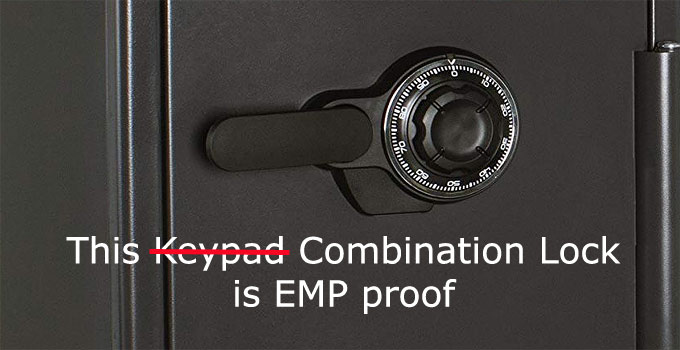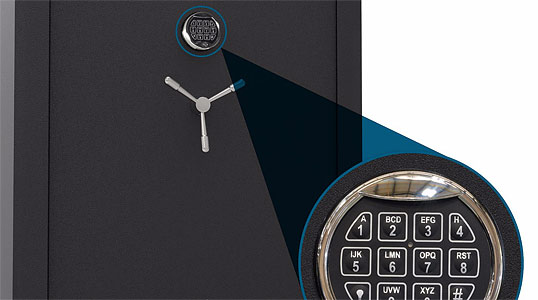Will EMP Fry the Electronic Keypad Lock on my Safe?

Awhile ago I received this question from a reader:
Saw some articles on EMP (my biggest fear).
In a moment of stupidity I bought a gun safe with a electronic lock instead of a dial lock. I just can’t get it out of my head that this will be a epic disaster if an EMP hits.
I was looking to place some sort of protection over the keypad and have seen an article that a cage resting over it may be of some protection. But I have also seen some EMP protection bags which I thought if you sealed over the keypad would accomplish the same thing. I think they are like Anti-static bags you get computer parts in.
So my question is would this work? Or would the metal of the safe channel the pulse into the backside of the keypad and fry it anyway? Is anything kept inside a gun safe also proofed against an EMP? I would think it is, but curious.
I would suspect that yes, the electronic locking mechanism of a safe will be at risk during a EMP event.
Although electronic locking mechanisms can be really convenient, they also cause me concern. Why? Because they all need a power source and they all have ‘electronics’ inside which could ‘break’.
Remove the power source or damage the electronics within the keypad and you’re locked out (although some also have a physical key lock mechanism for backup functionality – important!).
EMP & Electronic Keypads
Theoretically a nuclear EMP (electromagnetic pulse) at altitude may zap the atmosphere with up to 50,000 volts per square meter. Wow! There are caveats to that, however one might presume 50 KV may likely ‘fry’ electronic circuits! Even electronics not connected to the grid (a safe’s keypad) will receive a charged field jolt (again, with theoretical caveats).
Related: Nuclear EMP Components E1, E2, E3, and what they mean…
One accepted exception to this is the concept of a Faraday cage. A conductive skin (or small enough mesh) enclosure which would theoretically protect electronic contents inside (with enough dB attenuation at affected frequencies).
When we start talking about this, it gets technical (beyond the scope of this article). However there are factors such as strength of field, attenuation, and the electronic device itself. However I will offer a general opinion about the Safe and its Keypad…
If the safe is not entirely made of conductive metal, the EMP will get in.
Additionally, they have doors and therefore a gap around the perimeter. Depending on door design (gap dimension, folds) and EMP frequency bandwidth (wavelengths), some of the field strength may get in.
A electronic keypad is entirely exposed on the front surface. It will receive whatever ‘zap’ exists at that location during EMP.
Even if you cover up the keypad with conductive tape or mesh, there’s a problem… The safe is covered with paint or epoxy/enamel of some sort. The tape would need to be in conductive contact with the metal itself around the perimeter of the keypad. Are you going to scratch off all that paint on your pretty safe, just in case?
Anti-static Bag
The reader question mentioned Anti-static bag material. This is an interesting thought. That is, cover the entire safe with some sort of Mylar conductive foil bag.
The problem for starters is this: the bag might have to be pretty big… I’m not aware of ‘garbage bag’ sized Mylar bags.
Maybe one could be made from “Emergency blankets”. You know, those so called “space blankets” made of Mylar foil. Maybe cut them up, overlap edges and tape them together to form a bag sufficient to cover the safe. Sounds pretty ‘cheesy’.
Before covering with your makeshift Mylar Faraday bag, you might first cover the safe with a blanket to electrically insulate the safe itself from the conductive material.
Then there’s the problem of the bottom. How heavy is that safe?
See where I’m going?
All this sounds like quite a pain in the arse!
EMP proof Closet?
You might theoretically transform one of your closets to be EMP resistant. Maybe it’s tinfoil hat theory, but maybe not…
Line the walls, ceiling and floor (and door) with conductive material (more Mylar?) or fine metal screen mesh.
Then put a carpet or plywood on the floor to insulate.
You could keep your Safe (with its electronic keypad) inside this room (along with other electronic ‘stuff’). Would it work? Maybe, to an extent (with a bunch of theoretical caveats and such).
Did you tape all the corners, edges, to make it all conductive together? Then there’s the issue of the door edge perimeter gap.
How much attenuation (dB) would you actually get with just one layer of Mylar (probably not too much)? Would it be enough? “It depends” (don’t you love that answer?)
Again, a pain in the arse…
EMP Garbage Can
Will your safe fit inside a metal garbage can (makeshift Faraday cage)?
Probably not.
Here’s the solution to the Safe problem!
Buy a Safe with Combination Lock!
Next time, just buy a safe with a good old fashioned combination lock or key. Or at least a safe that has a alternative manual key to get it open.
Example: Extra Large Combination Safe
For my pistol safes, I have several biometric (fingerprint reader) safes. They’re excellent! I’m not worried about EMP. Why? Because they also have a key!
Related: Biometric Gun Safe Review Of SentrySafe Pistol Safe
That said, if you’re in the market for a personal Safe or a large upright gun safe (rifles, etc..) and if you are concerned about EMP, I would recommend getting one with a combination lock (or a backup key lock). Simple as that. It does make for slower access, but that can be dealt with in other ways.

